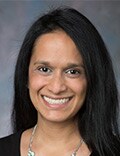Docs Can’t Be Bystanders in ‘Silent Scourge’ of Medical Bullying

Maya Iyer, MD, MEd, experienced bullying as a faculty member, and she sensed that she wasn’t alone. “The best ideas for research often come from individual experiences, in both personal and the professional academic medicine setting,” she told Medscape Medical News.

“And I was correct. I was not the only one who experienced bullying. In fact, the most severe bullying experiences among…women physician leaders occurred when they were in leadership positions,” said Iyer, a pediatric emergency medicine physician at Nationwide Children’s Hospital in Columbus, Ohio.
She is co-author of a study that was published August 23 in JAMA Open in which investigators surveyed the existence of antibullying policies for faculty at almost 100 US medical schools.

Dr Maya Iyer
The researchers defined bullying as “a severe form of mistreatment [that] occurs in the medical setting when a power differential allows offenders to consciously target individuals through persistent negative actions to impede the education or career of the target.”
The JAMA study included 91 medical schools, of which four schools had antibullying policies that included the reporting of procedures. Of the 87 medical schools without antibullying policies, 60 had antiharrassment policies; of those schools, 10 of the schools’ websites cited bullying and antiharassment policies. Five schools required a login to access policies, and one school’s website had a broken webpage link, per the study.
“We need to bring the silent scourge of bullying to the forefront because bullying is causing a brain drain on the medical profession,” said Iyer. “Bullying has numerous downstream negative effects, including depression, anxiety, burnout stress, decreased patient care satisfaction, increased medical errors, and job attrition.”
She added: “Through bullying, we are losing voices in medicine just at that point in time where we are trying to diversify the workforce to improve representation of all physicians.”
Iyer’s team sampled the top 25 schools for research and the top 25 schools for primary care. They also took a random sampling from 25 schools for research and a random sampling from top 25 schools for primary care. They assessed the following: (1) antibullying policies; (2) antiharassment policies that mentioned bullying; (3) antiharrassment policies that did not mention bullying; and (4) the absence of policies addressing these issues.
Policy comprehensiveness was another focus for the researchers. They evaluated whether the relevant policies included faculty members and articulated the institution’s commitment to providing a safe and healthy workplace. Other factors included defining bullying and the roles and responsibilities of employees and procedures for reporting bullying.
Physicians Can’t Be Bystanders to Bullying
Iyer called on physicians to “acknowledge that bullying in academic medicine exists and [to] speak up when they witness such events. This means transitioning from being a bystander to an upstander,” she said.
She doesn’t let medical schools off the hook, however. Instead, she advocates having institutions “provide safe spaces and opportunities for near-peer mentoring so that targets of bullying can share stories.”
Regarding who is responsibile for addressing bullying, Iyer is emphatic. “I do want to be clear that the onus of disrupting does not fall on the targets. Rather, we need to fix the systems in which such behavior is tolerated.”
Her advice to leaders in academic medicine is to create comprehensive, zero-retaliation bullying policies that include detailed reporting procedures. Iyer advises leaders to partner with colleagues in human resources, offices of equity, and ombudspersons to develop, implement, and enforce these policies.
JAMA Open Network. Published online August 23, 2022. Full text
Aine Cryts is a veteran health IT and healthcare writer.
For more news, follow Medscape on Facebook, Twitter, Instagram, and YouTube.
Source: Read Full Article